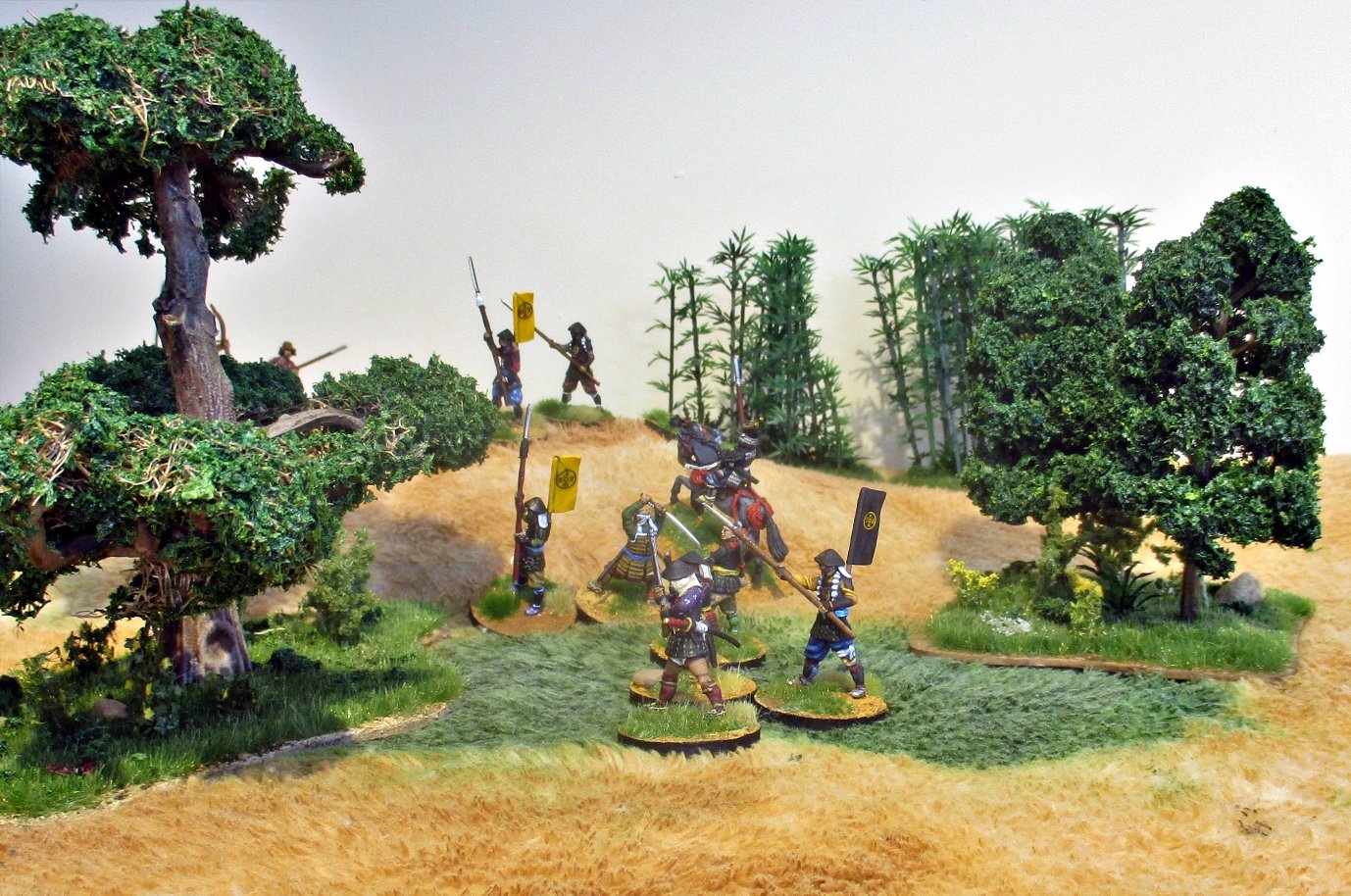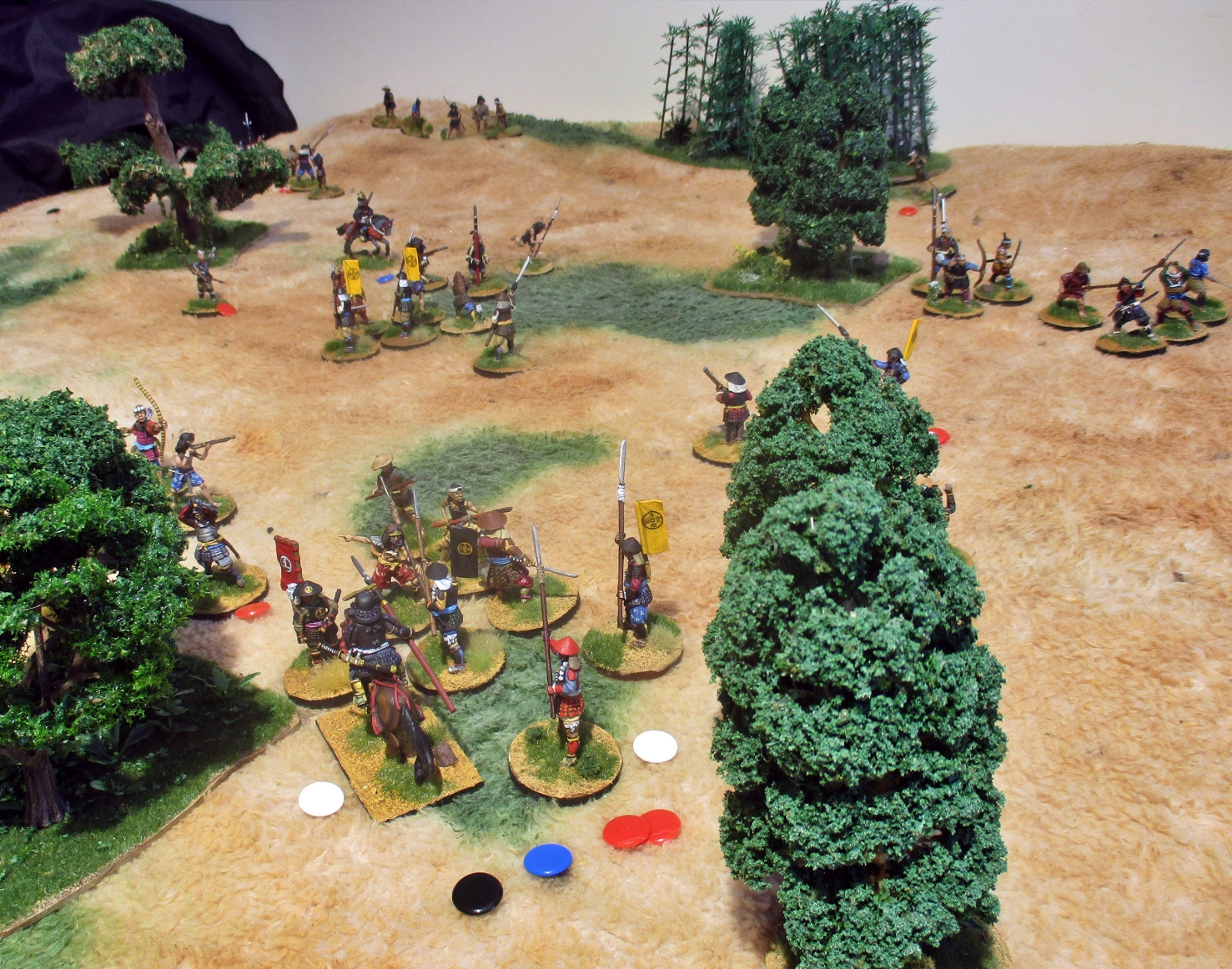As part of my ongoing quest to represent all levels of Sengoku Jidai warfare, I’ve recently revisited ‘large skirmish.’ By which I mean something larger than Test of Honour, so around 30 to 50 figures or so. I wanted the game to be able to track individuals rather than units, and this meant Feudal Patrol was the ideal framework. I’ve written a bit about Feudal Patrol previously, but the real advantage to it is how quickly it is able to resolve 1-on-1 combats because of the card system. This means you can speedily resolve combats involving multiple combatants and still have figures react as individuals. It also means you can form Feudal units of troops with different equipment and skills.
I wanted the game to be about inspirational leadership and occasional acts of individual merit, with units representing small feudal contingents. I envisaged a game where some figures would retreat and ‘lurk’ at the edges of the combat, and where the fighting would be sporadic resulting in far more wounds than deaths.
Most of the changes I made were to do with my own personal taste in skirmish games generally, rather than anything specific to the Sengoku. I think most skirmish wargames have much too high a casualty rate, so I slightly reduced weapon skills, and for these games reduced all wounds by 1. Initially, I’d thought about having a universal saving throw to negate wounds and have stuns instead, and I think this would be a better way to go. It would only involve turning an extra card.
I don’t like how wounded figures are usually handled either. Wounded figures usually just fight on with reduced effectiveness, whereas I think being wounded would be a great motivation for getting away from combat as quickly as possible. I therefore prevented wounded figures from initiating combat. And they could only be engaged if all unwounded figures in the group could be engaged first.
The other thing I did for these games was to use a square grid for movement. This was essentially because it makes it much easier to move things around and measure command radii when testing a game. I might end up keeping it because, well, I like grids.
I also brought in an overall ‘army morale’ system. Partly because I wasn’t always going to play a scenario with a turn limit, but mainly to try and get that effect of troops gradually melting away when things go against them. The system is:
Resolved morale counters for each side are kept track of until end of turn. At end of turn, subtract lower total from higher and distributed the remainder between the two forces by giving 2 to the side that had most resolved morale counters that turn, then 1 to the other side and so on until all the counters are exhausted. These morale counters are permanently attached to the force. When a force has a number of these permanent markers equivalent to the number of units it has, each of their units must resolve an extra morale card at the start of its activation. If the force has twice as many permanent morale counters it must resolve 2 extra morale cards, and so on.
I’d envisaged having to make a new set of morale cards, but as it turned out the existing ones worked OK. I changed the ‘in cover’ reference on the morale cards to mean ‘out of proximity to the enemy.’ I also treated wounded figures as having a lower guts rating than others of the same rating. So these were more likely to run away first. Figures outside of command radius do not activate at all, the leader has to go and get them. And if they are wounded they will retreat towards their table edge.
All told, the game worked more or less how I wanted. Very few figures were killed outright, and those that were were almost all shot with matchlocks. Lots of figures were wounded and most backed off successfully. The various groups gradually eroded as the game went on. So all good.
I’ve not made much in the way of specifically Japanese modifications. I didn’t bother with rules for exotic weapons like naginata, nodachi, tetsubo etc. While at this level, it’s entirely possible for the odd figure to be armed with such weapons, it didn’t seem worth trying to accommodate them. So melee weapons were either yari or katana. Troops were divided into ‘warriors’ (the majority) and ‘bushi.’ Bushi who engaged in combat have to engage another bushi if possible. The two classifications are similar to the more familiar ‘ashigaru’ and ‘samurai.’ But a lower class warrior could be classified as a bushi to represent a warrior intent on meritorious deeds in hope of reward. I’ll probably add something for the taking of heads next time too.
Feudal Patrol allows a fair bit of customisation and detail to be added to the figures. Of course, the more detail you add, the more complex the game becomes and everything takes a bit longer. So it’s a case of finding a happy medium when it comes to classifying figures in order to accommodate the desired number of figures. But the game itself is really a great toolkit for ancient and medieval skirmish games.
^ The cold reality of warfare: Status counters all over the place.







Those game shots look amazing.
Cheers,
Pete.
LikeLiked by 1 person
Thanks
LikeLiked by 1 person
Nice looking game as usual. Very lovely.
How do you manage to grid movement in that battlemat? I do not see any mark in the pictures.
Cheers!
LikeLiked by 1 person
The grid is marked by a dot of darker paint at the corners. It’s the same 10cm grid I use for battles. It’s easily visible when you’re looking down on the table close up, but mostly disappears with lower angle photos.
LikeLike
Thanks!
LikeLiked by 1 person
Looking good. I might have to give Combat Patrol a look.
LikeLiked by 1 person
By combat patrol I meant Feudal Patrol. 🙂
LikeLike
Combat Patrol is good too 😉
LikeLike